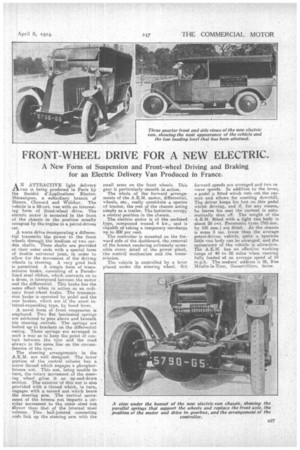FRONT-WHEEL DRIVE FOR A NEW ELECTRIC.
Page 11

If you've noticed an error in this article please click here to report it so we can fix it.
A New Form of Suspension and Front-wheel Driving and Braking for an Electric Delivery Van Produced in France.
AlcATTRACTIVE light delivery van is being produced in Paris by the Societe d'Applications ElectraMecaniques, a subsidiary branch of Messrs. Chenard and Vualeker. The vehicle is a 10-cwt. van with an interesting form of front-wheel drive. The electric motor is mounted in the front of the chassis in the position usually occupied by the engine in a petrol-driven car.
A worm drive incorporating a differential transmits the power to the front wheels throughthe medium of two cardan shafts_ These shafts are provided at their outer ends with a special form of double universal joint, in order to allow for the movement of the driving wheels in steering. A very good lock is permitted_ A simple form of transmission brake, consisting of a Ferodolined steel ribbon, which contracts on to a drum, is interposed between the motor and the differential. This brake has the same effect when in action as an ordinary front-wheel brake. The transmission brake is operated by pedal and the rear brakes, which are of the usual in • ternal-expanding type, by hand lever. A novel form of front suspension is employed. Two fiat laminated springs are anchored to pins above and beneath the steering swivels, The springs are bolted up to brackets on the differential casing.. These springs are arranged in such a Way as to keep the point of contact between the tyre and the road always in the same line an the circumference of the tyre. The steering arrangements in the E.M. are well designed. The .lower portion of the central column has a • screw thread which engages a phosphorbronze nut. This nut, being unable to turn, the rotary movement of the steering wheel gives it an up-and-down motion. The exterior of this nut is also provided with a thread which, in turn, engages with a second nut which bears the steerinr, arm. The vertical movement of the bronze nut imparts a circular movement to the outer steel nut flower than that of the internal -steel column. Two ball-jointed connecting rods link up the steering arm with the
small arms on the front wheels. This gear is particularly smooth in action.
The whole of the forward arrangements of the A.E.M. motor, differential, wheels, etc. really constitute a species of tractor, die rest of the chassis acting simply as a trailer. The batteries occupy
a central position in the chassis. .
The electric motor is of the enclosed type, compound wound 4 kw., and is capable of taking a temporary surcharge up to 300 per cent.
The controller is mounted on the forward side of the dashboard, the removal of the bonnet rendering extremely accessible every detail of the power plant, the control mechanism and the transmission.
The vehicle is controlled by a lever placed under the steering wheel. Six
forward speeds are arranged and two re verse speeds. In addition to the lever, a pedal is fitted which cuts out the current and allows for coasting downhill. The driver keeps his foot on this pedal whilst driving, and if, for any reason, he leaves his seat the current is automatically shut off. The weight of the A.E.M. -fitted with a light van hotly is about 28 evA. Pneumatic tyres (765 mm. by 105 mm.) are fitted. As the chassis is some 5 ins, lower than the average petrol-driven vehicle, quite a 'spacious little van body can be arranged, and the appearance of the vehicle ia attractive. The A.E.M. has an effective working range of AO to 50 miles when running fully loaded at an average speed of IS The makers' address is 26, Bite Moulin-la-Tour, Gennevilliers, Seine.






























